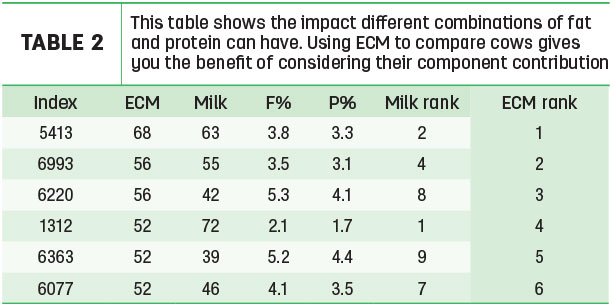Having focus is a good thing, but being singularly focused to measure profitability is not. We know with some certainty, herds which produce more milk or higher components have higher profitability.
But using only milk or components is too narrow of a view and does not assess efficiency or profitability accurat ely. To do this, you need a broader view like energy-corrected milk (ECM).
A recent large Midwest study of dairies found the difference in ECM between the most profitable one-third dairy herds and the bottom one-third was 19.9 pounds of ECM per cow. What’s that worth? Annually that’s $462 increased revenue per cow. It is also interesting to note, these herds also benefit from improved 21-day pregnancy rates, lower feed costs per hundredweight of milk, reduced somatic cell counts, lower death loss and fewer days open. Let’s take a closer look at ECM and how you can use it.
What is ECM & where do I find it?
ECM is calculated to find the amount of energy in the milk based upon its fat and protein content. To do this, milk volume is adjusted by correcting component values for each cow to 3.5 percent fat and 3.2 percent protein. In effect it levels the playing field, as it takes the question of milk yield and fat and protein content off the table by correcting it to a standard. As such, it can be used as a fair comparison from cow to cow, lactation to lactation or herd to herd.
You can find your ECM value in PCDART or your DHI specialist can help you by creating a custom report. If you are not yet using DHI, ECM can be cumbersome to calculate; however, not impossible. The formula for calculating your herd’s ECM is: 0.327 x milk pounds + 12.95 x fat pounds + 7.65 x protein pounds = ECM. See an example calculation in Table 1.

Take action
Avoid the pitfalls of being singularly focused when monitoring profitability in the herd. Since your dairy, along with all others in the Midwest, are paid for component yield, not just pounds of milk or component percentages, evaluating nutrition programs and solutions which impact ECM are worthy endeavors which will help improve your herd’s efficiency and profitability.

Below is a list of strategies to improve ECM. If you need help accessing your ECM data through DHI, talk with your specialist.
- Consider dietary changes carefully. There’s a balancing act between volume and input costs. Milk fat percentage is most sensitive to dietary changes and can vary over a range of nearly three percentage points, while milk protein concentration changes approximately 0.6 percentage units. When milk production is strong, but you have opportunity to increase components, you can expect similar improvements to these.
- Put up quality forages free from mycotoxins. This helps maximize rumen function.
- Ensure ration has adequate levels of fiber.
- Do not overstock, as it causes some cows to slug feed because they don’t have adequate time at the feedbunk.
- Balance for lysine and methionine. Before you do though, first evaluate the economics; it may not pay with low milk prices.
- Be careful of using high levels of non-protein nitrogen (NPN), which reduces protein yield. Heavy feeding of ensiled silages or ensiled grains, immature pasture and lack of rumen- undegradable protein are examples of this.
- Monitor sugar and starch levels. Feeding too much highly-fermented carbohydrates reduces rumen pH and causes milk fat depression.
- Genetics can be a long-term help by using bulls with high-predicted transmitting ability for combined fat and protein (CFP).
- Feed frequently, or if that is not possible, frequent pushups are necessary to avoid empty bunk syndrome.
- Implement good heat abatement during periods of heat stress.
- Prioritize good transition cow health. Avoid overcrowding to keep metabolic incidences low.
- Make bunk management a priority. Practice good packing methods, remove spoiled feed and minimize air exposure.
- Improve reproductive efficiency to keep days in milk low and production high.
- Don’t feed rations which encourage sorting.
- Don’t house first-lactation heifers with older cows in facilities which are full. They eat smaller mouthfuls more often and intakes will be severely impacted.
- Don’t have cows which are too fat or thin. Fat cows increase the risk of metabolic disease and calving difficulty and reduced production follows; while thin cows have minimal body stores which causes milk and component yields to suffer.
- Keep ration energy adequate to maintain strong milk production and high protein percentage. Be careful it is not too high, otherwise it will reduce milk fat.




